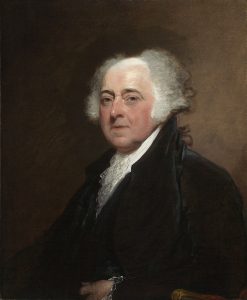
This October 30th marks the 288th birthday of John Adams, the second president of the United States. While often overshadowed by the other major players of the American Revolution, Adams' role should not be overshadowed. Few would deny he was a strong political philosopher with a keen intellect and fierce sense of integrity.
Adams was born in Braintree, Massachusetts. From a young age, Adams was fond of learning. His parents expected he would make a fine minister. Adams thought he would make a good teacher, but after a brief stint in the classroom, he decided a legal career was for him. Soon, he became one of the most notable lawyers in his home state.
In 1759, Adams met 15-year-old Abigail Smith. The two developed a close relationship, which led to marriage in 1764. Adams saw his wife as his intellectual equal and trusted her advice in all matters. They shared many values, particularly a staunch opposition to slavery. The two were happily married for over fifty years and had six children.
Tensions between the colonies and the British crown began to flare in the 1760s. Following the costly French and Indian War, the British taxed the colonies heavily. Adams was among the colonists who resented this. He wanted the British Parliament to treat the colonies with more fairness. However, conflict escalated with the Boston Massacre of 1770, when British soldiers shot into a crowd of colonists verbally and physically harassing them. While sympathetic to the colonists' hostility towards British policy, Adams defended the eight British soldiers and their commander charged with murder. Always wary of mob rule, he successfully argued that the incident was more nuanced than public opinion admitted.
Despite the backlash Adams received for his defense of the soldiers, he was still asked to join the First Continental Congress in 1774 and the Second Continental Congress in 1775. As the colonies moved closer to war with Britain, Adams helped draft the Declaration of Independence and raise the Continental Army. When the Revolutionary War came to an end in 1783, Adams helped negotiate the Treaty of Paris, which established peace with the British. In 1785, he became the first American ambassador to Great Britain.
In 1789, Adams became George Washington’s vice president and officially the first person to fill that office. When Washington declined to pursue a third term, Adams ran for the presidency himself. Narrowly beating out political rival Thomas Jefferson, Adams won the election and assumed the presidency in 1797. According to the law of the time, Jefferson’s second place ranking meant he became Adams’ vice president by default.
Adams’ presidency was marked by tensions between the Federalist and Anti-Federalist parties over how strong or weak the national government should be in relation to individual state governments. Adams was a Federalist who believed in a strong central government, while Jefferson was an Anti-Federalist who thought the opposite. This difference of opinion made their working relationship less than amicable.
International conflict also dominated Adams’ presidency. The French were displeased with Jay’s Treaty, a 1794 agreement signed between the US and Britain that was intended to foster friendlier relations between the two countries. The French and British being enemies, the French started seizing American ships in response. Adams sent a peace mission to the French. It was greeted with the demand that the Americans pay a monetary bribe in order for talks to commence. The request was denied and the American public was enraged.
National security became a major priority as war loomed. Adams strengthened American military forces while still hoping to avert bloodshed. Soon followed the most controversial part of his entire political career: the passing of the Alien and Sedition Acts, which increased the requirements for citizenship, made criticism of the government a punishable offense, and allowed the president to deport any foreigner deemed a threat to the country. These laws were meant to clear out spies and strengthen the Federalist party, but their unconstitutional nature only hurt Adams’ political reputation.
For all the controversy he generated, Adams was still determined to avoid war with France. He sent out a second peace mission to France in 1799 and this time it was successful. However, Adams would not secure a second term. The bitter presidential election of 1800 ended with Jefferson as the victor.
After leaving office, Adams retired to his Braintree home where he spent time working on an autobiography and tending to his farm. Surprisingly, Adams and Jefferson reconciled in 1812, maintaining a steady correspondence for the rest of their lives. In fact, Adams and Jefferson would die on the same day: July 4th, 1826, the fiftieth anniversary of the adoption of the Declaration of Independence.
This year marks the 288th birthday of John Adams, a major figure in early American history. Here are some resources on his life and work.


Add a comment to: October 30, 1735 – Birthday of John Adams, second president of the United States